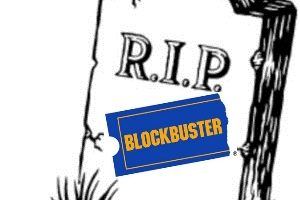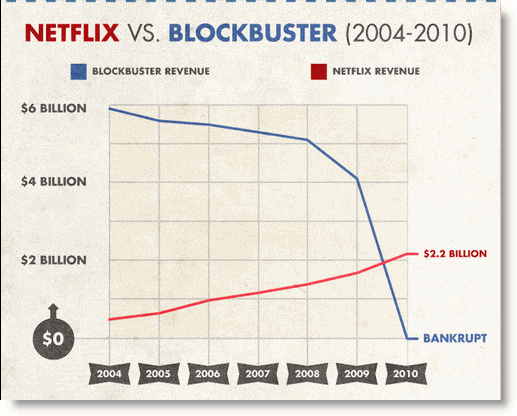Blockbuster: It’s Failure and Lessons to Digital Transformers

Blockbuster, a wildly successful national movie-rental chain, filed for bankruptcy 6 years after achieving $6 billion dollars in revenue. Why did this happen and what lessons can we learn from it?

As a teenager growing up in America in the late 1990s/early 2000s, I was a frequent customer of Blockbuster – the largest movie rental retail chain with a strong brand and stores across the country. Its revenues impressively climbed to around $6 billion dollars in 2004 only to suffer a crashing descent into bankruptcy in 2010.[1] The reasons behind this failure reveal valuable lessons to future digital transformers and business leaders. I will first summarize the original business model in terms of value creation and value capture and then will offer an analysis of its failure with accompanying lessons.
Business Model
Value Creation
Blockbuster movie rental retail stores offered a wide selection of movies, but focused mainly on new releases. It’s 9,000 stores allowed customers to easily walk through aisles of movies advertised with their DVD cases in order to make a selection.[2] It built a strong brand with 100% recognition and attempted to offer a customer-friendly experience with movie popcorn, candy, and snacks also available for purchase.[3]
Value Capture
Blockbuster captured value by owning physical copies of movies that could be rented enough times to exceed the cost of purchasing. It cost from $2-$5 typically to rent a film, new releases commanding higher prices than old films. Each time a customer rented a movie, they agreed to a time and day for return. Late fees, which comprised an estimated 70% of profits, were added to a customer’s account if they did not meet the return deadline.[3]
Why it failed?
After synthesizing analyses on its unraveling, I think these things most contributed to the failure:
- They were making a lot of money: While Netflix was just beginning its DVD-by-mail service and later its streaming/online service, Blockbuster was still earning billions of dollars in revenue using its current model. Additionally, the margins and markets for these new offerings did not appear as attractive as its established model.[3] Why even pay attention to these new ideas if the markets are small and the margins slim?
- Changing competitive landscape: Blockbuster was challenged not only by the startup Netflix, but also eventually by powerful technology companies (Apple and Amazon) and cable companies with streaming and video-on-demand services. It struggled to compete against both, especially when it was late to the game (see number 4 below).
- Operating model implications: Pursuing a new business model with either a DVD-by-mail or streaming/online service required the current operating model to change significantly as Blockbuster would need to shift from its brick-and-mortar approach with retail stores to an entirely new way of functioning that was unknown. This only further encouraged Blockbuster to continue focusing on where it was still earning profit.
- Failure to recognize timing: Blockbuster actually responded to all of its perceived competitive threats with similar models, but it was too late. It eventually tried a DVD-by-mail service, rental kiosks similar to Redbox, and put up its own website for online streaming after acquiring a smaller player in the field.[4] While Blockbuster’s CEO from 2007-2011, Jim Keyes, recognized that his organization was behind the curve in DVD-by-mail and kiosk services, he thought that they were not late to the streaming/online service world, and confidently stated that Blockbuster could leverage its strong brand to win:
http://www.nbcnews.com/video/cnbc/35710480#35710480
In this industry, changes occur rapidly, and Blockbuster was left in the dust.
Lessons learned
Blockbuster’s demise offers many lessons. Here are some of the salient ones to me:
- Currently unattractive opportunities can become very attractive opportunities in our changing world.
- Current success is easily distracting and can blur vision when considering new opportunities or threats.
- Transformation can happen very quickly, and if you miss it, it can be very unforgiving.
- Brand strength and/or past successes are not enough to compete against new digital transformers.
- It didn’t have to end this way – Blockbuster had a chance to purchase Netflix for $50 million [5] and could have identified the streaming/online trend much earlier.
[1] https://dealbook.nytimes.com/2010/09/23/blockbuster-files-for-bankruptcy/?_r=0
[2] http://www.ibtimes.com/sad-end-blockbuster-video-onetime-5-billion-company-being-liquidated-competition-1496962
[3] http://hbswk.hbs.edu/item/clayton-christensens-how-will-you-measure-your-life
[4] http://www.nytimes.com/2007/08/09/business/09movie.html
[5] http://www.businessinsider.com/blockbuster-ceo-passed-up-chance-to-buy-netflix-for-50-million-2015-7
Image sources:
https://www.linkedin.com/pulse/4-lessons-from-blockbuster-failure-david-reiss
http://go-digital.net/blog/wp-content/uploads/2011/02/netflix-vs-blockbuster-revenues.gif
http://mentalfloss.com/article/77285/11-secrets-former-blockbuster-employees





Nicely summarized the battle between Blockbuster and Netflix Tyler! I agree to your assessment that in today’s dynamic digital age past success is no guarantee for future successes for established companies. Based on the Blockbuster-Netflix saga and other similar happenings in different industries what do you think can the big players do or adopt as a strategy to keep themselves from becoming irrelevant (since the new digital business model seems unlucrative to them in its infancy)?